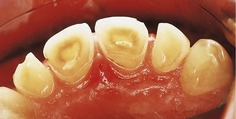Case• 60. Toothwear
SUMMARY
A 35-year-old policeman presents having noticed that his anterior teeth are becoming shorter. Identify the cause and outline options for management.
History
Complaint
The patient has become increasingly aware of his shortening front teeth. He is not greatly concerned about the appearance but feels that continued wear will eventually destroy the teeth completely.
History of complaint
He has noticed that his teeth have become worse over the last 3–5 years but cannot remember when he first noticed the signs. The patient has always attended a dentist regularly and has relatively few, small restorations and good oral hygiene.
Medical history
The patient is generally fit and well. He drinks about 10–20 units of alcohol each week.
Examination
Extraoral examination
The patient is a fit-looking man and slightly overweight. No submandibular or cervical lymph nodes are palpable. The temporomandibular joints appear normal and there is no evidence of hypertrophy of the masseter muscles.
Intraoral examination
▪ The appearance of the anterior teeth is shown inFigure 60.1. What do you see?
The palatal surfaces and incisal edges of the upper incisor teeth are worn. The wear involves the enamel and dentine but not the pulp. The palatal surfaces of the teeth appear smooth and unstained. The incisal edges are rough, small chips of unsupported labial enamel having fractured away.
If you were able to examine the patient, you would find that some of the upper and lower anterior teeth do not contact each other in the retruded contact and the intercuspal positions. All other teeth appear normal and the palatal surfaces of the upper posterior teeth are unaffected.
▪ What does this appearance signify?
This is toothwear, the loss of dental tissues through the processes of erosion, attrition and abrasion. Although each process may act alone, significant toothwear is usually the result of a combination of these processes and erosion is often dominant.
The smooth surfaces suggest that erosion is a factor in this case and the distribution of enamel loss suggests that regurgitation of gastric acid may be the cause. Dietary acids are usually associated with erosion on the buccal or labial surfaces of the upper anterior teeth but if the patient rinses or swills acidic drinks in the palatal vault prior to swallowing, the pattern of erosion is very similar to that seen when gastric acid is regurgitated. Either source of acid might be the cause.
▪ Define erosion, abrasion and attrition.
Erosion is the chemical dissolution of teeth by acids.
Attrition is the wear of tooth against tooth. Mild degrees of attrition are normal.
Abrasion is the wear of teeth by physical means other than the teeth.
Differential diagnosis
▪ What is your differential diagnosis for this patient?
1. Dental erosion caused by gastric acid combined with attrition
2. Dental erosion caused by dietary acids combined with attrition
3. Attrition alone
4. Industrial erosion.
Stay updated, free dental videos. Join our Telegram channel

VIDEdental - Online dental courses



